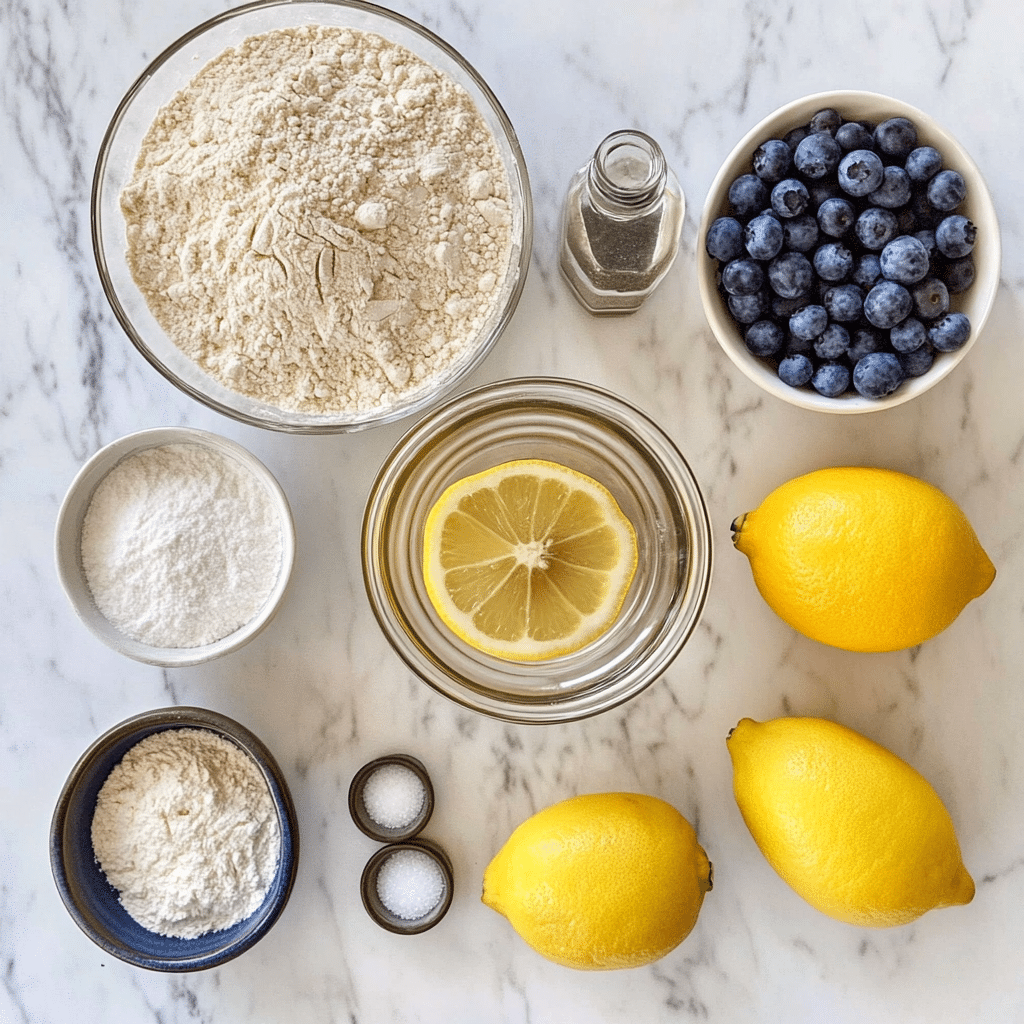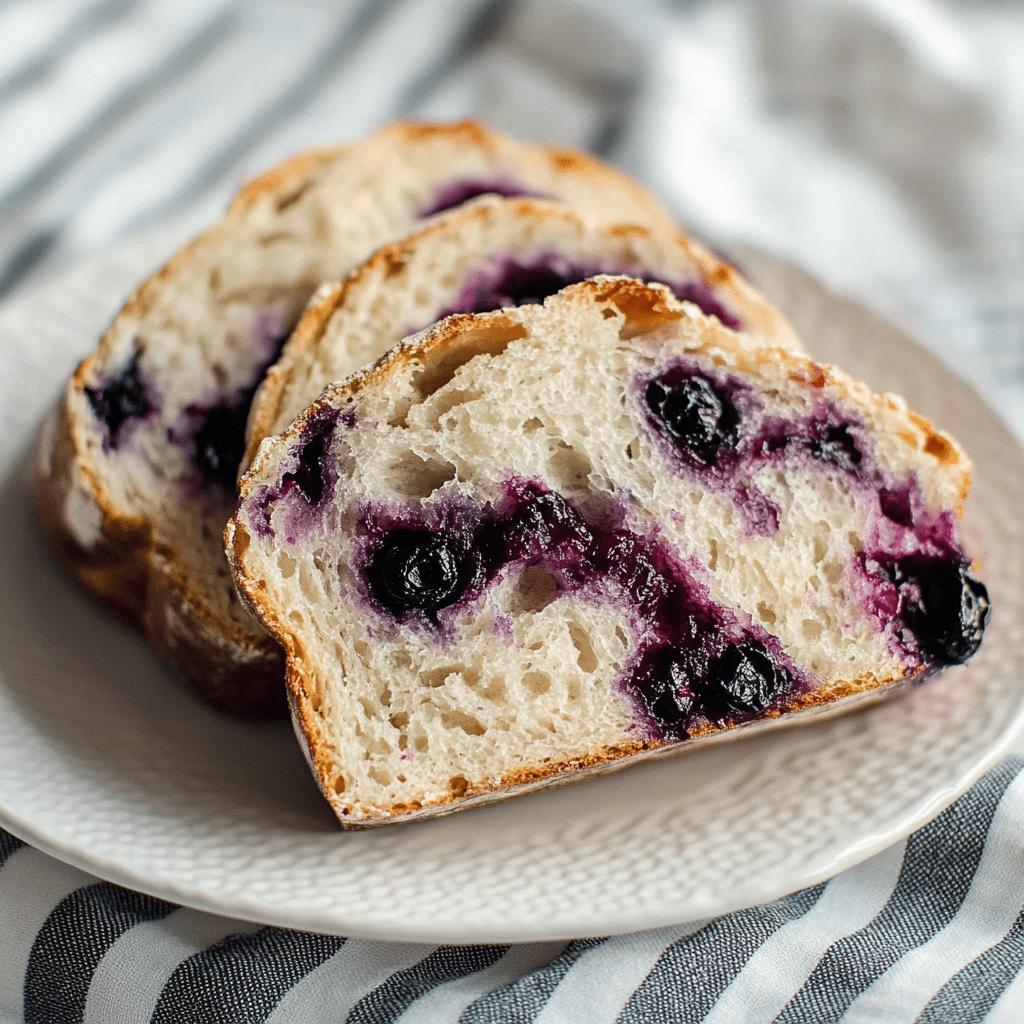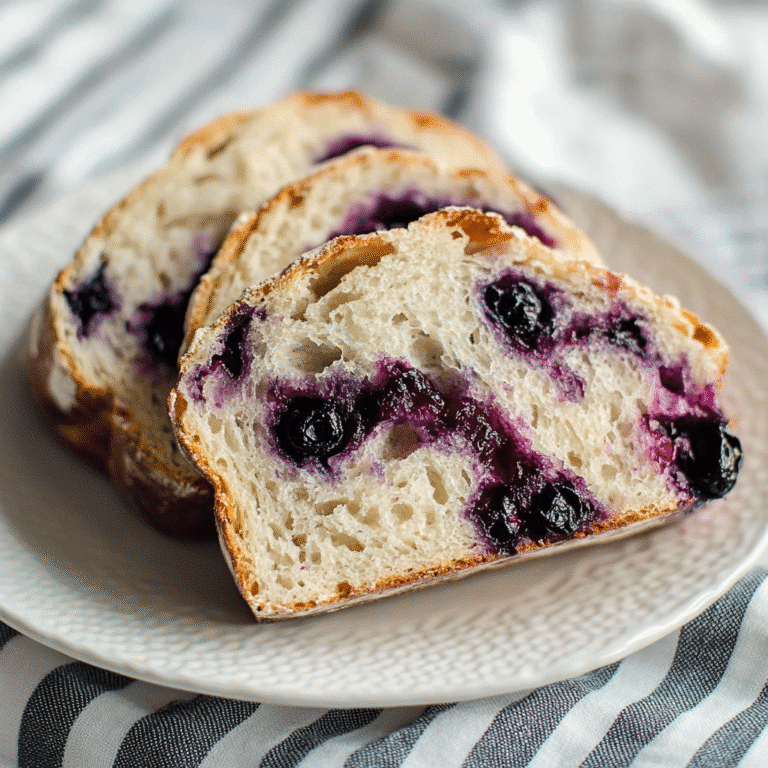Making bread from scratch is more than a recipeit’s a ritual. And when it comes to turning a loaf into a showstopper, nothing beats the sweet and tangy flavor combo of Blueberry Lemon Sourdough Bread. If you’re new to sourdough or looking to level up your baking game with seasonal ingredients, this guide is your go-to kitchen companion. Inspired by my love for bold, nourishing flavors and real, homemade food (yes, the kind that tastes like comfort and looks like joy), this article breaks down exactly how to create a loaf that’s equal parts rustic and refined.
Thank you for reading this post, don't forget to subscribe!We’ll walk through every step of making this fruity artisan bread: from picking the right blueberries and lemons to troubleshooting dough issues and baking to golden perfection. You’ll even learn how to stop those juicy berries from sinking to the bottom and how to tweak the recipe if you’re using frozen fruit or discard starter.
Whether you’re baking for brunch, gifting a loaf, or meal-prepping breakfast that isn’t boring, you’re in the right place.
Don’t miss our Sourdough Discard Soda Bread if you want even more cozy sourdough ideas.
Table of Contents
Why Blueberry Lemon Sourdough Bread Is Unique
What sets blueberry lemon sourdough apart from classic sourdough
Blueberry lemon sourdough bread stands out as a vibrant twist on the traditional sourdough experience. Where classic sourdough leans on tang and simplicity, this version elevates the loaf with bursts of juicy berries and refreshing lemon. The result is a balanced bread that tastes bright, sweet, and slightly tart in every bite.
Unlike sugary breakfast breads, blueberry lemon sourdough bread keeps its integrity as a rustic, naturally leavened loaf. It’s ideal for those who want a fruit-forward artisan bread without artificial flavors. The addition of real lemon zest and whole blueberries transforms each slice into a moment of bakery-level bliss, whether served toasted, buttered, or simply fresh from the oven.
The flavor profile of blueberries and lemon in tangy dough
The flavor combination in blueberry lemon sourdough bread is unforgettable. Fermented dough provides its signature tang, while blueberries contribute natural sweetness that softens the crumb. The lemon zest offers a punchy, aromatic layer, and when paired with the sourdough base, it creates a delightful flavor balance—neither overly sweet nor overly sour.
As the bread bakes, the lemon oils spread through the dough, giving it a fresh citrus scent. The blueberries burst during baking, adding both moisture and subtle fruity ribbons throughout the loaf. This isn’t just bread it’s an experience layered with flavor, fragrance, and texture.
Nutritional benefits of adding fruit and citrus to sourdough
Blueberry lemon sourdough bread doesn’t just look and taste beautiful it packs nutritional perks too. Blueberries are known for being antioxidant-rich, loaded with vitamin C and fiber. Lemons bring extra brightness along with their own benefits, especially for immune and digestive health.
When these ingredients are combined with wild yeast fermentation, the result is a gut-friendly, nutrient-dense loaf. Traditional sourdough is already easier to digest thanks to its natural leavening process. Add in fresh fruit and citrus, and this sourdough becomes a smart choice for flavor lovers who care about wholesome ingredients.
Discover great ideas like Cottage Cheese Banana Bread if you want to try more creative, nourishing loaves.
Print
Blueberry Lemon Sourdough Bread
- Total Time: 6 hours 45 minutes
- Yield: 1 large loaf
- Diet: Vegetarian
Description
A vibrant, rustic artisan loaf with juicy blueberries and bright lemon zest, perfect for brunch or a cozy breakfast.
Ingredients
- 500g bread flour
- 100g active sourdough starter (or 120g discard for denser loaf)
- 300ml water (adjust for frozen berries)
- 10g salt
- 150g fresh or frozen blueberries
- Zest of 2 lemons
- 1 tbsp lemon juice
- Optional: 1 tsp vanilla extract, 1–2 tbsp honey or maple syrup, 1–2 tsp poppy seeds, 1/4 cup chopped nuts
Instructions
- Feed your starter 4–6 hours before baking or use discard if preferred.
- Mix flour, water, and starter. Rest (autolyse) for 30 minutes.
- Add salt, lemon zest, lemon juice, and any optional flavorings. Mix gently.
- Perform stretch-and-folds every 30 minutes during a 2–3 hour bulk fermentation.
- After the second fold, gently add blueberries (frozen berries should be floured).
- Shape the dough into a loaf. Avoid crushing the berries. Place in a floured proofing basket.
- Proof at room temperature 1–2 hours or refrigerate overnight.
- Preheat oven with Dutch oven to 475°F.
- Score dough and bake covered for 20 minutes. Uncover and bake 20–25 more minutes at 450°F.
- Cool completely before slicing.
Notes
To prevent berries from sinking, keep them dry and coat in flour. For best results, use small firm berries and add after dough develops strength. Reduce hydration slightly when using frozen fruit.
- Prep Time: 6 hours (including fermentation)
- Cook Time: 45 minutes
- Category: Breakfast, Brunch
- Method: Baking
- Cuisine: Artisan, American
Ingredients That Make the Difference
Choosing fresh vs frozen blueberries for baking
When making blueberry lemon sourdough bread, choosing the right blueberries matters. Fresh blueberries are ideal because they hold their shape and don’t release too much liquid into the dough. They add pops of flavor and color without making your crumb overly wet.
However, don’t worry if all you have are frozen blueberries. You can absolutely use them, especially if they’re wild or small in size. The key is to keep them frozen right up until mixing and coat them lightly in flour to reduce bleeding. This simple tip helps maintain a clean, artisan appearance in your fruit-filled sourdough.
The best lemons for zest and juice
Lemons are the star flavor enhancer in blueberry lemon sourdough bread, so quality counts. Look for organic lemons with bright yellow skin and a strong citrus scent. Meyer lemons are sweeter and less tart, offering a more delicate flavor, while regular lemons give a sharper bite.
Both zest and juice are important. The zest infuses the dough with aromatic citrus oils, which spread during fermentation and baking. The juice adds brightness and acidity, balancing the fermented taste of the sourdough. For best results, zest the lemon before juicing to preserve the oils and avoid bitterness.
Sourdough starter: active vs discard
Your starter is the backbone of every sourdough recipe. For blueberry lemon sourdough bread, an active, bubbly starter works best if you want a lofty, open crumb. Feed your starter 4–6 hours before baking and let it double in size before adding it to your dough.
That said, you can also use sourdough discard in this recipe, especially if you prefer a denser texture or want to reduce waste. Using discard results in a slightly milder rise and a more moist crumb perfect for a rustic breakfast loaf.
If you enjoy working with discard, don’t miss our Cloud Bread Breakfast Sandwich for another great use.
Add-ins and optional twists
While the base ingredients are blueberries, lemon zest, and sourdough starter, there’s room to play. Consider adding:
| Ingredient | Flavor Benefit | Use Quantity |
|---|---|---|
| Poppy seeds | Adds crunch and visual appeal | 1–2 teaspoons |
| Vanilla extract | Warms up citrus tones | 1 teaspoon |
| Honey or maple syrup | Enhances sweetness naturally | 1–2 tablespoons |
| Chopped nuts | Adds texture and richness | 1/4 cup (optional) |

These variations won’t overpower the sourdough but can personalize your loaf. Keep additions minimal to avoid interfering with the structure of the dough.
Step-by-Step Recipe Guide
Preparing your starter for enriched sourdough
To make perfect blueberry lemon sourdough bread, it all begins with the starter. Make sure your sourdough starter is active, bubbly, and has been recently fed. If it floats in water, it’s ready to use. Aim to feed your starter about 6 hours before mixing the dough.
If you’re short on time, using mature sourdough discard can still work. The rise will be slower and the texture denser, but the flavor remains rich and satisfying. The important part is ensuring the starter isn’t overly acidic or neglected, which can negatively affect the dough’s strength.
Mixing and folding with delicate ingredients
Begin by mixing your flour, water, and starter. Allow the dough to rest for autolyse typically 30 minutes. This step improves gluten development and makes the dough more elastic. After resting, add salt, lemon zest, and a little lemon juice. Fold the dough gently using the stretch-and-fold method.
Once the dough starts building strength, carefully fold in your blueberries. For best results, add blueberries after the second set of folds to avoid crushing them. If you’re using frozen blueberries, toss them in flour first. This prevents bleeding and helps distribute them evenly through your sourdough.

Repeat gentle folds every 30 minutes over a 2 to 3-hour bulk fermentation period. This process strengthens your dough without over-mixing your delicate fruit.
Final proofing and shaping for a rustic look
After bulk fermentation, shape your dough into a round or oval loaf on a floured surface. Avoid kneading or squeezing the dough too much you don’t want to burst those juicy blueberries. Use a bench scraper to help you handle the dough without deflating it.
Place the shaped loaf in a proofing basket or bowl lined with a towel. Cover and refrigerate overnight or allow a final rise at room temperature for 1–2 hours until slightly puffy. Chilling the dough overnight helps develop a deeper, citrus-infused flavor and gives your blueberry lemon sourdough bread a gorgeous oven spring.
Baking tips for a golden crust and moist crumb
Preheat your Dutch oven or baking stone to 475°F at least 30 minutes before baking. Remove the dough from the fridge, score it with a sharp blade, and transfer it to the hot oven.
Bake covered for 20 minutes to trap steam, then uncover and reduce the temperature to 450°F. Continue baking for another 20–25 minutes until the crust is deep golden brown and the loaf sounds hollow when tapped.
Let the bread cool completely before slicing. This resting period ensures the crumb sets properly and helps highlight the fruit and citrus flavors throughout your loaf.
Don’t miss our Sourdough Discard Soda Bread for another quick, flavorful bread option.
Preventing Common Baking Mistakes
How to keep blueberries from sinking in the dough
One of the most common issues when baking blueberry lemon sourdough bread is blueberries sinking to the bottom of the loaf. This often results in an uneven bake and soggy base. To prevent this, use small, firm blueberries and make sure they are as dry as possible. Pat fresh berries dry with a paper towel. If you’re using frozen blueberries, keep them frozen until the moment you add them.
Coating the berries lightly in flour before folding them into the dough also helps suspend them throughout the loaf. Fold them in gently during the second or third stretch and fold not at the beginning to maintain the structure of the dough and avoid crushing the berries.
Preventing overhydrated or underdeveloped dough
Adding fruit to any sourdough recipe introduces extra moisture. In blueberry lemon sourdough bread, this can lead to overhydrated dough that spreads too much during proofing or doesn’t hold shape. To combat this, slightly reduce your water content when using juicy blueberries or add more folds during bulk fermentation.
Underdeveloped dough is another issue. Always autolyse and perform a full set of folds to build gluten structure. If your dough tears easily or remains sticky despite several folds, it needs more rest time and stronger gluten development.
Adjusting hydration when using frozen berries
Frozen blueberries tend to release more water as they thaw inside the dough. To maintain the ideal hydration level, reduce the water in your base recipe by about 5–10%. This gives your fruit-filled sourdough the best chance of holding shape and baking evenly.
Also, ensure you’re not using oversized berries, which can release even more juice and create pockets of wet dough that don’t bake through properly.
Tips for avoiding a gummy texture
A gummy or dense interior is a sign of underbaking, excess moisture, or insufficient fermentation. To fix this, make sure your loaf is fully proofed look for visible bubbles and a puffy shape before baking.
Use a thermometer to check the internal temperature. A properly baked sourdough loaf, including blueberry lemon sourdough bread, should reach at least 200°F in the center. If the loaf cools too quickly, it may also become gummy, so let it rest on a wire rack for at least an hour before slicing.
For another approach to rustic loaves with less hydration risk, check out Cottage Cheese Banana Bread for an easy, moist alternative.
Serving and Storing the Loaf
Best ways to slice and serve blueberry lemon sourdough
Once your blueberry lemon sourdough bread is fully cooled, it’s time to enjoy it. Use a sharp bread knife to slice the loaf, starting from the center if you want to preserve softness in the cut ends. Each slice should reveal a golden crumb with visible blueberries and streaks of lemon zest.
This loaf shines at breakfast or brunch. Serve it toasted with a pat of salted butter or cream cheese for a sweet-salty balance. It also pairs beautifully with honey, lemon curd, or even a drizzle of maple syrup. Want to go bold? Try it with mascarpone and fresh blueberries for a bakery-style brunch plate.
For savory lovers, a thin slice alongside a citrusy salad or grilled chicken can elevate lunch in a fresh, unexpected way.
Flavor pairings for brunch or dessert
Blueberry lemon sourdough bread has a versatile flavor profile that fits both sweet and savory occasions. Here are some pairing ideas:
| Serving Style | Pairing Suggestion |
|---|---|
| Toasted with spreads | Butter, honey, lemon curd |
| Breakfast platter | Scrambled eggs, turkey bacon, fruit |
| Dessert plate | Whipped cream, blueberry compote |
| Afternoon snack | Almond butter, banana slices |
You can even use it to make French toast or a sweet bread pudding. The citrus flavor holds up well to added spices like cinnamon or cardamom.
How to store sourdough bread for freshness
To keep your blueberry lemon sourdough bread fresh, avoid storing it in plastic, which traps moisture and softens the crust. Instead, wrap the loaf in a clean tea towel or store it in a paper bag. Place it in a bread box at room temperature and consume within 3 days.
If the crust begins to harden, revive slices by lightly toasting them. Avoid refrigerating the loaf, as it will dry out more quickly in cold air.
Can you freeze this bread and reheat it?
Absolutely. This bread is freezer-friendly. Slice the cooled loaf, wrap individual pieces in parchment paper, and place them in a freezer-safe bag. Stored properly, blueberry lemon sourdough bread can last up to 2 months in the freezer without losing its flavor or texture.
To reheat, simply toast the frozen slices directly or warm them in the oven at 300°F for 8–10 minutes. This method helps restore the crisp crust and preserves the moisture of the fruit-filled crumb.

Conclusion: Bring Artisan Flavor to Your Kitchen
If you’re looking to elevate your sourdough routine, blueberry lemon sourdough bread is a must-try. It’s vibrant, naturally sweet, and just the right amount of tangy. With the richness of fermented dough and the brightness of citrus and berries, it delivers everything you love about classic sourdough with a twist.
From choosing the right ingredients to learning how to fold in the blueberries without losing structure, this guide has given you all the tips to nail the perfect fruit-forward loaf. Whether you enjoy it as a brunch centerpiece, an afternoon snack, or a freezer-friendly treat, this bread offers homemade comfort and flavor in every slice.
Want more ideas to bake with bold flavor? Don’t miss our Sourdough Discard Biscuits for another easy and hearty recipe using your starter.
FAQs About Blueberry Lemon Sourdough Bread
What makes blueberry lemon sourdough bread different from regular sourdough?
The main difference lies in flavor and texture. Blueberry lemon sourdough bread combines the tangy base of traditional sourdough with the sweet, citrusy notes of blueberries and lemon zest. This creates a more vibrant taste and a slightly softer crumb, with colorful fruit and fragrant citrus infused throughout the loaf.
Can I use frozen blueberries in blueberry lemon sourdough bread?
Yes, frozen blueberries are perfectly fine to use. Keep them frozen until just before folding them into the dough to prevent bleeding. Lightly coating them in flour helps distribute them evenly and prevents sinking.
How do you prevent blueberries from sinking in sourdough bread?
Use small, firm berries and add them after the dough has developed structure—usually after the second set of folds. Coat them with a bit of flour and avoid overmixing. Cold dough also helps; chill it briefly before shaping to minimize sinking.
What type of lemon is best for sourdough bread, zest or juice?
Both zest and juice are important. Zest offers strong citrus aroma and infuses the crumb with lemon oil, while juice adds tartness and moisture. Regular lemons give a sharper flavor; Meyer lemons offer a milder, sweeter profile. Always use fresh zest for best results.
Can I use sourdough discard for this recipe?
Yes, discard results in a denser, moister loaf. While an active starter creates better rise and texture, discard delivers tangier flavor and reduces waste. Adjust proofing times since discard ferments more slowly.
How long does it take to make this bread from start to finish?
It typically takes 16 to 24 hours depending on proofing. Here’s a rough timeline:
Starter feed: 4–6 hours
Mixing and bulk fermentation: 4–5 hours
Final proof (overnight): 8–12 hours
Baking and cooling: 1.5–2 hours
👉 Want to see more recipe tips, flavor pairings, and behind-the-scenes updates?
Follow us on Facebook: Recipe by Clara – Official Facebook Page

